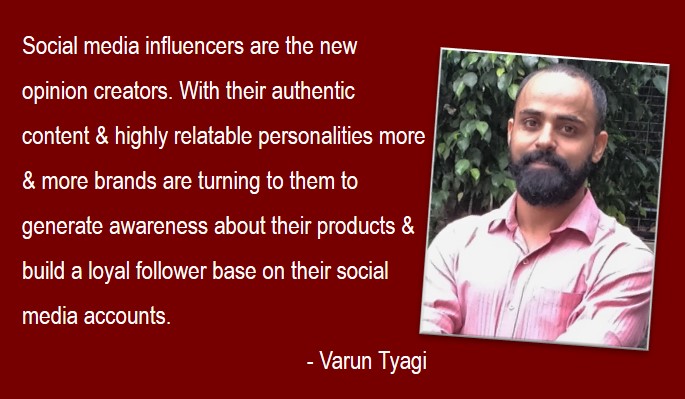Public Relations finds its roots in word-of-mouth publicity, which has been around now for as long as people have been communicating, and has been one of the simplest yet effective marketing tools.
For the last few decades, PR has essentially translated into maintaining and leveraging relationship with mass media – TV, Print, Radio. However, with the emergence and ever-so-growing popularity of social media, influencer marketing is beginning to carve out a niche of its own within Public Relations. Social media influencers are the new opinion creators – with their authentic content and highly relatable personalities – and more and more brands are turning to them to generate awareness about their products and build a loyal follower base on their social media accounts.
As custodians of all brand relationships, PR consultancies are presented with interesting opportunities and unique challenges alike due to the rising popularity of social influencers as a marketing channel. To continue to stay relevant and impactful, PR firms are adopting a robust, data-driven approach to leverage the opportunities, while successfully countering the challenges. Here’s a look at how the profession seems to be shaping up right now.
Three Reasons Why Public Relations Needs to Focus More on Influencer Marketing
According to Captiv8, brands are globally already spending more than $255 million on influencer marketing every month, and that’s just on Instagram. Influencer marketing is growing exponentially, and there is more than one reason why PR firms should start focusing on social influencers.
- Build consumer engagement and trust
Social influencers share strong personal connects with their audience, which is a big reason why their audience engages with their content, and believes what they have to say. In fact, contrary to the prevailing notion that celebrities command the power to sway mass opinion, there’s an emerging trend of micro-influencers (also known as local influencers) who are more popular with their follower base as their personalities and content resonate more. By connecting and collaborating with these influencers, it is possible to consistently produce higher engagement numbers while keeping the messaging genuine and low cost.
- Create a unified customer experience
With the spawning of social media sites, people are consuming content at all times. This demands an always-on content strategy, and this is where influencers become an indispensable channel to activate. With the help of influencers, PR firms can engage their customers across channels, locations, and time zones, create content that is engagement-worthy, and target audience in different stages of the customer lifecycle – from awareness to consideration to conversions.
- Chance to Get Creative
Let’s be honest – millennials don’t read brochures, reports, or press releases. According to a survey by Statista, millennials spend a total of around four hours consuming TV, Radio, and Print. In comparison, they are spending close to nine hours browsing the internet, surfing social networking sites, using emails and texts, and on online forums. When it comes to the kind of content consumptions, millennials spend most of their time watching videos on YouTube, consuming ephemeral content – ‘stories’ – on Facebook and Instagram, binge watching shows, and reading short news via apps. Influencers get this, and they keep playing with creative means to keep their audience engaged. It’s about time for PR to get through to their target audience by breaking the content clutter via influencers.
Three Challenges that PR Firms Face When Doing Influencer Marketing
The social-sphere is growing exponentially, and managing Influencers using excel sheets is simply not enough. In fact, it is time PR consultancies replace the human efforts with the right technology tools and keep up with the pace. The biggest challenges faced by them can easily be addressed by using the right technology.
- Finding Right Influencers
Brands are willing to incentivize influencers generously – from paying money per post to spoiling influencers with freebies and goodies – and this has led to a spurt in the number of ‘influencers’. But not everybody with a million followers actually exerts tangible social influence. If done right, a relevant micro-influencer can be 6.7 times more cost-effective than a celebrity influencer with millions of followers. A deeper analysis of an influencer’s profile is required to examine the nature of influence they exert (if any). This requires deep-diving into their cross-platform presence, audience growth numbers and demographic quality, engagement numbers on each platform, and much more. PR firms need to proceed with caution as there is a large number of fake influencers out there, and a data-backed approach is the best way to mitigate the risks of partnering with someone who doesn’t add any value to your marketing efforts.
- Relationship Management
The fundamental difference between influencer marketing and PR is that the former is more of a two-way street. Relationships form the centerpiece of influencer marketing. Remember, influencers are not a marketing channel; they are real people with real opinions and emotions. PR consultancies need to put effort into finding the right people, and then focus on exploring mutually beneficial, long-term relationships. This ensures that influencers start acting as brand ambassadors in the long run, prompting them to organically advocate for the brand and even come forth in times of an online crisis.
- Dedicated, specialised approach
With the rapid growth of influencer marketing, and a growing acceptance of the importance of influencers marketing by brands, consultancies need to start focusing on creating Influencer Marketing Centers of Excellence. PR firms too will eventually have to make a shift from a tactical approach towards influencer marketing to a broader strategic focus. These CoEs will have to look beyond optimising the ROI of existing influencer campaigns, and build standardised, data-driven influencer programs.
These trends suggest that PR firms are changing the way businesses do marketing by building a data-driven approach to influencer marketing sooner than they might think, and a strategic investment in technology based influencer marketing and intelligence solutions might go a long way in that journey.
The views expressed here are that of the author and do not necessarily reflect that of Reputation Today.







Be the first to comment on "How Influencer Marketing is Transforming Public Relations"